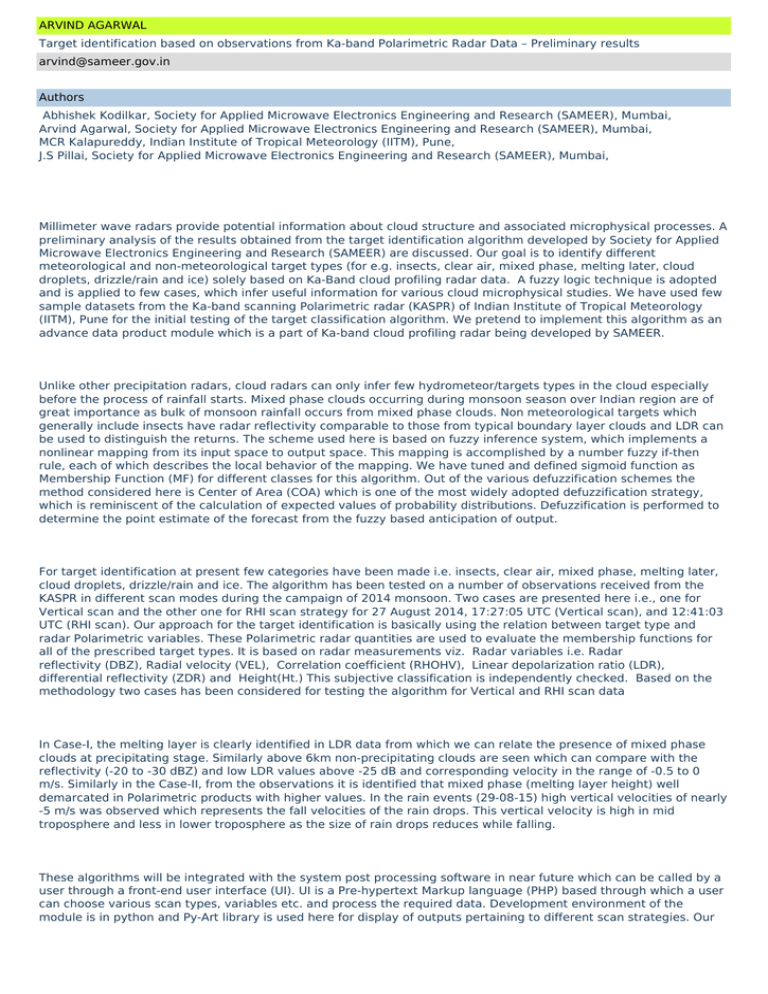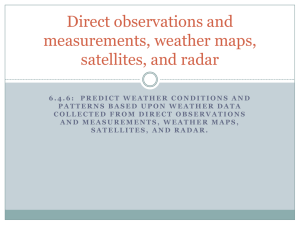ARVIND AGARWAL Target identification based on observations
advertisement

ARVIND AGARWAL Target identification based on observations from Ka-band Polarimetric Radar Data – Preliminary results arvind@sameer.gov.in Authors Abhishek Kodilkar, Society for Applied Microwave Electronics Engineering and Research (SAMEER), Mumbai, Arvind Agarwal, Society for Applied Microwave Electronics Engineering and Research (SAMEER), Mumbai, MCR Kalapureddy, Indian Institute of Tropical Meteorology (IITM), Pune, J.S Pillai, Society for Applied Microwave Electronics Engineering and Research (SAMEER), Mumbai, Millimeter wave radars provide potential information about cloud structure and associated microphysical processes. A preliminary analysis of the results obtained from the target identification algorithm developed by Society for Applied Microwave Electronics Engineering and Research (SAMEER) are discussed. Our goal is to identify different meteorological and non-meteorological target types (for e.g. insects, clear air, mixed phase, melting later, cloud droplets, drizzle/rain and ice) solely based on Ka-Band cloud profiling radar data. A fuzzy logic technique is adopted and is applied to few cases, which infer useful information for various cloud microphysical studies. We have used few sample datasets from the Ka-band scanning Polarimetric radar (KASPR) of Indian Institute of Tropical Meteorology (IITM), Pune for the initial testing of the target classification algorithm. We pretend to implement this algorithm as an advance data product module which is a part of Ka-band cloud profiling radar being developed by SAMEER. Unlike other precipitation radars, cloud radars can only infer few hydrometeor/targets types in the cloud especially before the process of rainfall starts. Mixed phase clouds occurring during monsoon season over Indian region are of great importance as bulk of monsoon rainfall occurs from mixed phase clouds. Non meteorological targets which generally include insects have radar reflectivity comparable to those from typical boundary layer clouds and LDR can be used to distinguish the returns. The scheme used here is based on fuzzy inference system, which implements a nonlinear mapping from its input space to output space. This mapping is accomplished by a number fuzzy if-then rule, each of which describes the local behavior of the mapping. We have tuned and defined sigmoid function as Membership Function (MF) for different classes for this algorithm. Out of the various defuzzification schemes the method considered here is Center of Area (COA) which is one of the most widely adopted defuzzification strategy, which is reminiscent of the calculation of expected values of probability distributions. Defuzzification is performed to determine the point estimate of the forecast from the fuzzy based anticipation of output. For target identification at present few categories have been made i.e. insects, clear air, mixed phase, melting later, cloud droplets, drizzle/rain and ice. The algorithm has been tested on a number of observations received from the KASPR in different scan modes during the campaign of 2014 monsoon. Two cases are presented here i.e., one for Vertical scan and the other one for RHI scan strategy for 27 August 2014, 17:27:05 UTC (Vertical scan), and 12:41:03 UTC (RHI scan). Our approach for the target identification is basically using the relation between target type and radar Polarimetric variables. These Polarimetric radar quantities are used to evaluate the membership functions for all of the prescribed target types. It is based on radar measurements viz. Radar variables i.e. Radar reflectivity (DBZ), Radial velocity (VEL), Correlation coefficient (RHOHV), Linear depolarization ratio (LDR), differential reflectivity (ZDR) and Height(Ht.) This subjective classification is independently checked. Based on the methodology two cases has been considered for testing the algorithm for Vertical and RHI scan data In Case-I, the melting layer is clearly identified in LDR data from which we can relate the presence of mixed phase clouds at precipitating stage. Similarly above 6km non-precipitating clouds are seen which can compare with the reflectivity (-20 to -30 dBZ) and low LDR values above -25 dB and corresponding velocity in the range of -0.5 to 0 m/s. Similarly in the Case-II, from the observations it is identified that mixed phase (melting layer height) well demarcated in Polarimetric products with higher values. In the rain events (29-08-15) high vertical velocities of nearly -5 m/s was observed which represents the fall velocities of the rain drops. This vertical velocity is high in mid troposphere and less in lower troposphere as the size of rain drops reduces while falling. These algorithms will be integrated with the system post processing software in near future which can be called by a user through a front-end user interface (UI). UI is a Pre-hypertext Markup language (PHP) based through which a user can choose various scan types, variables etc. and process the required data. Development environment of the module is in python and Py-Art library is used here for display of outputs pertaining to different scan strategies. Our main intention is to develop and implement these algorithms into a full-fledge software module. These modules will help users to identify and distinguish meteorological and non meteorological targets and the variation with different seasons in near future. Further modifications in this algorithm require some adaptations, which include both the finetuning of the membership functions and fuzzy rules and will be taken into account simultaneously within the system development. Powered by TCPDF (www.tcpdf.org)






